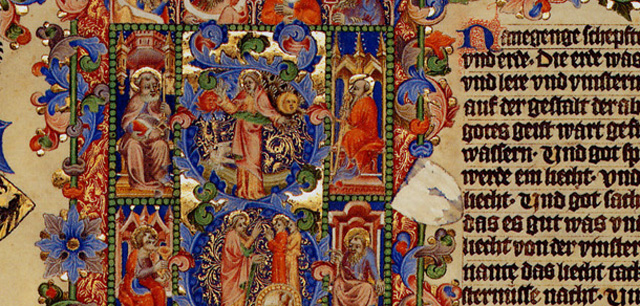Location
Josefsplatz 1, 1010 Vienna
had-slg@onb.ac.at
Opening Hours
At the cradle of book printing: The holdings of manuscripts form the germ cell of the Austrian National Library and are one of the world’s most important collections. Among the pieces from late antiquity, the medieval period, and the modern era there are major works from almost all written cultures. Old prints are also held here: incunabula, printed materials from 1501 to 1850 inclusive, and especially rare, valuable or bibliophilic prints with no time limits, and special holdings such as Hebrew, Chinese or Japanese writings.
Luxurious manuscripts of early modern times, especially from the possessions of Emperor Friedrich III (1415/1452-1493), Emperor Maximilian I (1459/1508-1519) and Emperor Ferdinand I (1503/1531-1564) form the major part of the Manuscript Collection. One of the most impressive works is the Byzantine Viennese Dioscurides, a collective manuscript on botany-pharmacology produced in Constantinople in about 512 and is one of UNESCO’s world heritage documents. Other high points of the collection are the Viennese Genesis from the 6th century, the Hrabanus-Maurus Codex from the 9th century, the Admonter Gigantic Bible from about 1150, the famous Wenceslaus Bible (about 1400), and a luxurious copy of Cicero’s speeches from the 15th century library of Matthias Corvinus.
The collection of incunabula with about 8,000 copies is one of the world’s most valuable of its kind. About one fifth of all titles printed in the 15th century are present, for example, the only copy of the Gutenberg Bible of 42 lines (Mainz 1454/55) to be found in Austria.
The printed matter holdings from 1501 to 1850 are among the world’s biggest with several hundred thousands of prints. The Department holds important printed works from the provinces of the Habsburg Monarchy, books in all the written languages of Europe, as well as unique prints from all over the globe. Also important is the collection of historical broadsheets, imperial letters patent, circulars and decrees, and the unique holdings of pamphlets and official documents on the Revolution of 1848.
Finally, in the Department you find as well comprehensive holdings of historical newspapers and periodicals that include the „Wiennerisches Diarium“, founded in 1703, that still exits today under the title „Wiener Zeitung“ and so is regarded as the world’s oldest daily newspaper still being published.
Catalogues
Search the catalogues of manuscripts
Search the catalogues of rare prints

